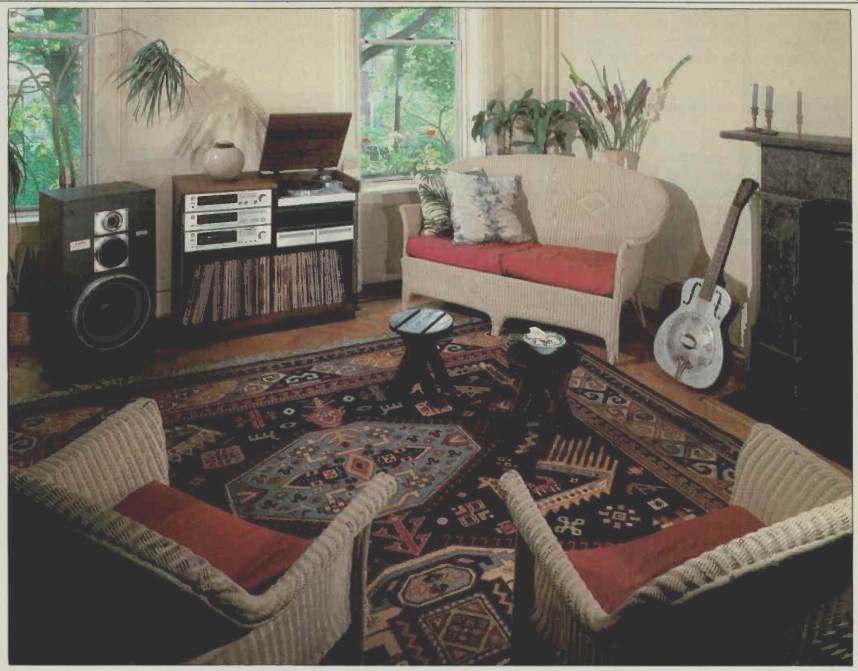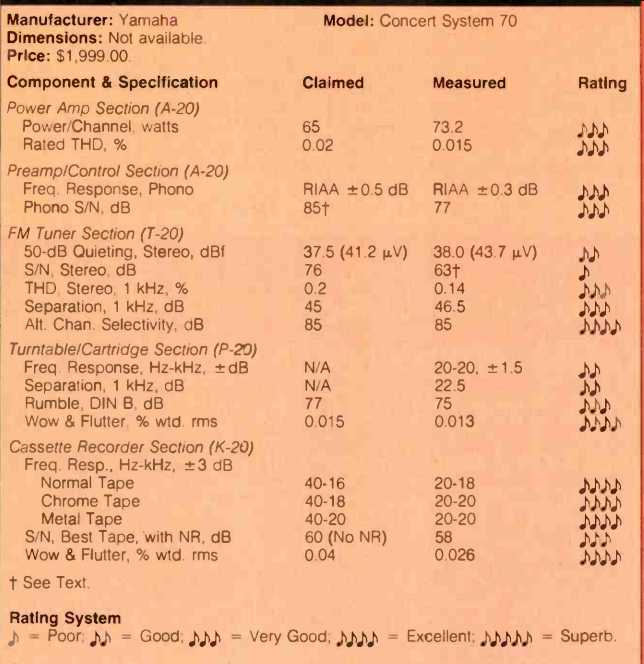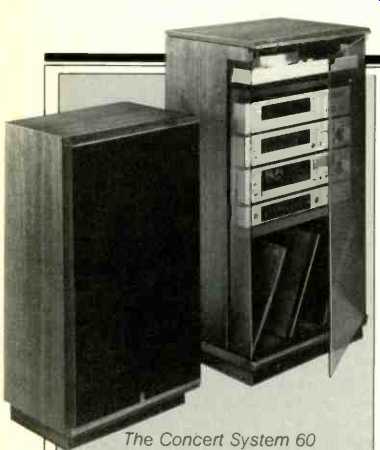
Yamaha's approach to matched component system design is, in my view, a brilliant
one. They have designed a group of components which could very well be sold
as separates (their specs and features are that good) and, in assembling them
into attractive total systems, they have added features which offer real user
features. Chief among these is a unique control-signal arrangement which obviates
the need for the user to select program sources at the amplifier's front panel.
For example, if you insert a cassette tape into the supplied K-20 cassette
deck and press its "Play" button, the integrated amplifier will automatically
switch over to the tape mode. The same thing happens with the tuner (when you
turn on its power or depress one of its preset buttons) and with the turntable
(when its "Play" button is depressed).
Essentially the same electronic and tape deck components are supplied for either the Yamaha Concert System 70 or the Concert System 60. These include a full featured, powerful (65 watts/channel rated, at 8 ohms, 20 Hz to 20 kHz, with no more than 0.02% THD) integrated amplifier, Model A-20, a matching AM/FM stereo digital frequency-synthesized tuner (Model T20), a stereo cassette deck (Model K20), and a fully automatic, direct-drive turntable (Model P-20) with a pre mounted magnetic cartridge. Both systems also include a pair of three-way loudspeakers (with 12-inch woofers, 4-inch midrange drivers, and 1 inch dome tweeters) housed in oiled walnut veneer cabinetry. A cassette storage drawer component is supplied in the Concert System 70 but is an option with the Concert System 60. Optionally available equipment for both systems include Model DT-2 digital timer and Model GE-5 graphic equalizer. The chief difference between the two systems is in cabinetry configuration. The Concert System 70 is supplied with a horizontally oriented "low-boy" cabinet in the same finish as the loudspeakers, while the Concert System 60 features a vertical cabinet with glass doors. Suggested retail prices are $1,999.00 for the System 70 and $1,899.00 for the System 60.
The A-20 integrated amplifier has prominent output level displays which read power directly in watts referred to 8 ohms. This amplifier serves as the central component of the entire system, and in order for its automatic function selection to operate, special control signal plugs from the cassette deck, tuner and turntable must be plugged into appropriately marked receptacles on its rear panel. An important feature for which Yamaha separate components are admired is incorporated into this amplifier: The totally independent loudness control which enables you to reduce listening levels without altering the main volume control while achieving proper bass and treble compensation for low-level listening levels. A unique fade-out/fade-in control need only be touched once to provide a gradual 20 dB of muting for answering phone calls or doorbells, and touched again to smoothly fade up to previously desired volume levels. Since the system includes a tape deck, which needs to be connected via one tape loop, a second signal-out/ signal-in loop is provided (and selectable at the front panel) for connection of other add-ons such as the optional graphic equalizer. Bass and treble tone controls are conventional, with center points mechanically detented for easy flat-response setting.
As the overall rating chart indicates, the amplifier exceeded both its rated power output and its distortion claims by a comfortable margin. Phono frequency response was excellent, and the measured signal-to-noise ratio of 77 dB does not suggest a failure to meet specs (Yamaha claimed 85 dB). Rather, it is because Yamaha still measures phono hum-and-noise by a now-obsolete test method, whereas I use the new EIA Amplifier Measurement Standard; the reading of 77 dB is quite good.
= = = = =

--- ONE-BRAND SYSTEM RATINGS: General Comments
Power Amplifier: Sound quality excellent, reliable operation with no tendency to overheat.
Preamp: Superb loudness control arrangement; system takes advantage of component interrelationships (see text).
Turntable & Cartridge: Smooth, silent and automatic; cartridge chosen could have had better specs and lower tracking.
Tuner: Weakest link of the system, but received acceptable FM and stereo FM; perfect tuning and favorite station presets a definite plus here.
Cassette Deck: Superb panel layout, easy to use, and performs extremely well with all premium types of tape, from normal to metal. Great human engineering here--this is the star component of the system.
Overall Comment: I admired the automated control feature (see text).
Overall Rating: 4/ 5
= == = =

----- The Concert System 60 features a vertical cabinet, glass doors.
The T-20 AM/FM tuner features manual or automatic scan tuning as well as the ability to store six AM and six FM stations for instant recall at the touch of a button. Tuning is precise, thanks to the frequency-synthesized quartz phase-lock-loop tuning system. There is, therefore, no need for a center-tune indicator, though the T-20 does have a "station lock" light which comes on when the tuner zeroes in on a station. Signal strength is shown with a five LED display. Small batteries installed at the rear serve as a backup for station memory storage in case of a power failure or if the a.c. outlet is accidentally unplugged. While I regarded the basic performance of the FM section of this tuner as adequate, my chief criticism was the inordinately high levels of subcarrier (19 and 38 kHz) products which were present in its output. Used with a cassette deck that is not equipped with proper filtering, this could lead to poor recording quality, especially when Dolby noise reduction is used. Fortunately, since Yamaha had total control of the entire system here (an advantage of the one-brand approach), they chose to incorporate such filtering into the K-20 cassette deck instead of designing appropriate filters for the tuner so that it would have no problems with any deck.
As for the cassette deck, it has a most unusual single transport control "pad" which handles all tape motion (fast forward, rewind, play and stop) depending upon which section of the pad is depressed--sort of a flat joystick arrangement that's easy to use. Tape selection is completely automatic, with the deck able to accommodate normal, high-bias (chrome or equivalent), and metal tapes properly.
Dolby B noise reduction is incorporated, as is a momentary record-mute button. Both in terms of frequency response and its other electrical specifications and in terms of its ease of use and features, I regarded this little deck as the outstanding component in the group, without in any way demeaning the others. In my tests, I used TDK-AD as the normal tape sample, TDK-SA for the high-bias tape, and TDK-MA as the sample of metal tape.
While I found an excellent 75 dB DIN B rumble figure for the P-20 turntable system, I was even more impressed by the 60 dB unweighted rumble figure scored by this fully automatic player. Wow and flutter was also outstandingly low. Response of the supplied cartridge extended well out to beyond 20 kHz but exhibited a slight peak at around 16 kHz or so. I feel the turntable is capable of handling a cartridge that requires somewhat less than the 2.0 grams of tracking force demanded by the unidentified pickup supplied by Yamaha. The P-20 owner's manual says very little about the cartridge other than its weight and required tracking force. I would urge users who are not totally satisfied with this choice of cartridge to upgrade to a better one. Yamaha, incidentally, has been nice enough to throw in an extra tonearm headshell for just such a contingency!
My overall impression is that this system is by far the closest to a high-grade separate component system that I have seen. The fact that Yamaha has included fine cabinetry and matching speakers and has taken advantage of features that could only be incorporated when all elements of the system are under a single manufacturer's control makes the Concert System 70 that much more desirable.
-Leonard Feldman
(Source: Audio magazine, Aug. 1982)
Also see:
Yamaha CX-10000 Preamplifier (Jan. 1989)
Yamaha Model B1 Power Amplifier (Aug. 1975)
Yamaha M-70 Power Amplifier (Jan. 1984)
Yamaha Model CR-2020 Stereo Receiver (Equip. Profile, June 1977)
= = = =